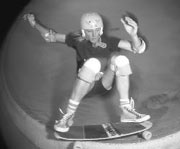DOGTOWN AND Z-BOYS
directed by Stacy Peralta opens May 3 at Metro
THE BEST documentaries transport you to a world that you didn’t know existed. They don’t teach lessons. Instead of the same old stodgy racism-is-bad and tolerance-is-good documentaries that the Oscars reward annually, the form is being revitalized both by technology—chiefly digital video—and an emphatically personal philosophy that says, “Here’s my story; I’m not pretending it’s objective.”
Such is the case with skateboarder-turned-director Stacy Peralta, whose Dogtown and Z-Boys deservedly won two Sundance awards last year. His documentary is part home movie—chronicling his youth and those of his skateboard team cohorts—and part corporate-sponsored video. Dogtown contains countless product placements for Vans, and also indirectly pushes the wares and skateboard videos of Peralta and Tony Alva (another featured rider), but the effect is thoroughly winning—and far less crassly commercial than, say, Pokéman.
In the early ’70s, a motley band of blue-collar kids from the bad part of Santa Monica, Calif. (“Dogtown”) gained the backing of a local surf shop. Using sticky new urethane wheels and a surfing-influenced, low-to-the-pavement technique, the Zephyr Skating Team (Z-Boys) revolutionized the sport at a 1975 national competition; then its most talented members sought fame and fortune separately, sundering their improvised family.
A cheerfully self-aggrandizing affair, Dogtown features overwritten narration delivered by Spicoli himself (Sean Penn), but the hyperbole doesn’t detract much from a fun staccato barrage of still photos, old film clips, and then-and-now profiles of its three principal subjects. World champions Peralta and Alva have the happiest stories to tell; they contrast sadly with that of Jay Adams, as Dogtown‘s postscript makes clear.
Though the film’s resolutely good- natured and relentlessly energetic, an underlying poignancy comes from its juxtaposition of the joyously uninhibited kids with their careworn middle-aged selves. It’s much like Michael Apted’s acclaimed Seven Up series, which follows its subjects from youth to maturity—but who wouldn’t rather watch dazzling teen skateboarders carve up empty swimming pools than pasty-faced Brits talking in cow pastures?
VISITING SEATTLE recently, Stacy Peralta and Tony Alva vigorously defended their Gerald Ford-era youth against the mocking clich鳠of disco and the mirror ball. “Maybe this is dangerous in saying this, but actually in looking back, I think the ’70s was a fantastic decade,” Peralta declares. “But it was always looked at as being a cultural wasteland. Yet as a result, a lot of things were able to grow. We were constantly being told, living on the West Coast, by the people on the East Coast that there’s no culture here.”
Alva adds, “We lived in Santa Monica, where the surfing and the low-riders and all of the street was the culture. And also, here we are right next door to Malibu and Hollywood. We were affected by all the different little pockets of Los Angeles. It’s not like we were just immersed in the surf culture.”
Of Dogtown‘s peppy, low-budget aesthetic, Peralta explains, “We were so low-tech that we had to figure out how to do the stuff that we didn’t have the money for. The one thing we didn’t want was to let this be a Ken Burns documentary. We did not want this to . . . be methodical and be textbooklike. It should feel and look like the subject matter.”
“We were big fans of all those surf movies,” Alva says of the ’70s. “But eventually we started to show up in those surf movies that we idolized, too.” Skateboarder magazine also featured the Z-Boys in several subsequent articles—now the basis for a companion book to Dogtown.
Super-8 footage and still photographs documented these historic early sessions, but as Peralta concludes, “I don’t think anybody at that time had any idea they were doing it for posterity.”
B.R.M.








